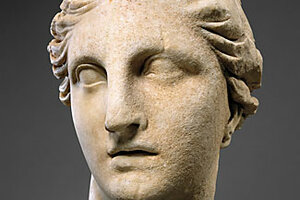New York's freshest shows
From ancient sculpture to Van Gogh's night inspirations, the best of this season's art.

‘Head of Athena’ is in a tribute show at the Met.
COURTESY OF THE METROPOLITAN MUSEUM OF ART
New York
New York puts on its sparkly best for the holidays, and this season's art offerings are equally glittery.
• The Metropolitan Museum of Art offers a tribute to its esteemed director, retiring after 31 years, in the form of a gala exhibition: "The Philippe de Montebello Years: Curators Celebrate Three Decades of Acquisitions" through Feb. 1. With 300 objects representing the crème de la crème of the 84,000 works collected during de Montebello's tenure, the show's a holiday treat.
Arranged chronologically by the year acquired, the pieces strike up a dialogue across the 5,000 years of their production. A wooden Kongo power figure from the second half of the 19th century, stabbed all over with nails to release its power, personifies force. The carved figure of a man seems to speak across the ages to a Jackson Pollock drip painting, "#28" (1950), which embodies another kind of force, also bristling with primeval energy.
The paintings are a trove of masterpieces: from Rubens to Rothko. As for sculpture, a massive, antique "Head of Athena" serenely communes with Brancusi's sleek, white arc called "Bird in Space" (1923). A 1904 Charles Rennie Mackintosh oak washstand, ornamented with blue tile and mirror-glass petals, shines opposite an evening gown (circa 1965) by Madame Grès, its silk folds falling like streams of water.
•The Museum of Modern Art, until Jan. 5, offers a mesmerizing look at the dark side of Vincent Van Gogh: in "Van Gogh and the Colors of the Night." In 30 works from all phases of his short career, the painter explored nocturnal scenes portraying dusk, twilight, and full-on night. Dependent on observation for his images, the painter would stick candles on his hat brim so he could paint after sunset. He finally succeeded in seeing in the dark when he planted his easel under a gas lamp outdoors to paint the astonishing "The Starry Night over the Rhône" in 1888. In this work and the iconic "The Starry Night" (1890), van Gogh merged imagination and representation, investing real scenes with intense emotion, expressively rendered through swirling brush strokes and throbbing color.
The night sky, and nature in general, were consoling forces for the troubled painter, seeming to offer a means to merge his individual soul with the overarching cosmos. In 1888, he wrote of "a terrible need for, shall I say the word – religion – so I go outside to paint the stars."
•A contemporary artist who captures the ethereal beauty of light is photographer William Eggleston, whose retrospective "William Eggleston: Democratic Camera, Photographs and Video, 1961-2008" is at the Whitney Museum of American Art through Jan. 25. The Memphis photographer (born 1939) is credited with bringing respect for color to fine-art photography through his images of Southern Gothic scenes. Using a dye-transfer process that enriches some hues and makes the pictures almost pop off the walls, he achieves luscious colors that lend layers of psychological complexity to seemingly simple images. A poet of the banal, Eggleston makes the familiar seem deeply strange, like his shot of a bare light bulb against a cherry-red ceiling, crisscrossed by white electric cords ("Greenwood, Mississippi," 1973). The images are never conventionally pretty but are arresting in their originality, achieved through focusing on incongruous detail and his off-kilter point of view.
More than 150 prints display Eggleston's seemingly improvisatory, snapshot aesthetic. The exhibition is like a road trip through the dusty, cobwebbed corners of a very quirky mind, the visual equivalent of a William Faulkner story or Eudora Welty on acid.
•The vibe from another show at the Whitney couldn't be more different: "Alexander Calder: The Paris Years, 1926-1933," through Feb. 15. Here, the circus is in town! You'll smile through the whole exhibition, even though it encompasses the formative period before Calder developed his signature, airy mobiles, kicking sculpture off its pedestal, reducing mass as its main feature, and making it dance in the wind.
The show deals with Calder's years in Paris where he hobnobbed with other modernist innovators like Mondrian and Duchamp, while indulging his love for line in fun (and funny) wire sculptures. His 1928 version of Jimmy Durante shows the comedian's oversized proboscis and bushy eyebrows. Although it consists of only a few twisted wires, the likeness is totally recognizable, for Calder was as brilliant as Matisse in evoking a whole image with a few lines.
A video shows Calder performing a toylike circus he created, inhabited by cute denizens fabricated from bits of string and fabric, like a lion with a yarn mane, ring master, knife-thrower, and trapeze artists. Marcel Duchamp described his friend's buoyant art as "pure joie de vivre." Calder never outgrew his inner child, and this exhibition is as jolly as a playground.
•For a completely different take on sculpture, the Japan Society presents an exciting fusion of old and new, tradition and innovation in "New Bamboo: Contemporary Japanese Masters" through Jan. 11. This is bamboo as you've never seen it before, woven and shaped into fanciful forms that are stunning in their complexity and daring.
More than 90 works by 23 artists show a "post-basket" aesthetic in which artisans trained in centuries-old techniques liberate themselves from formulae to create boldly inventive objects. "Non-functional" these exploded baskets may be, but they prove you can teach an old medium new tricks. Morigami Jin's "Reclining II" (2004) is like an open-weave Henry Moore sculpture, a web of bamboo strips that's no longer a literal container but which contains great promise for the future of a new art form.
